The DAS was replaced by the HyperPuff in 2017
Patagonia discontinued the DAS parka in 2017. They worked with a supplier to develop a new proprietary insulation, HyperDAS, that is warmer for its weight and more durable than the two Primaloft insulations used in the DAS parka. The new jacket is called the HyperPuff.
We chose not to test the HyperPuff because three believable people (Colin Haley, Patagonia Ambassador; Casey Shaw, manager of advanced research and development; and Walker Furgeson, field testing manager) told us that the old DAS has (had) a higher warmth to weight ratio than the HyperPuff. The HyperPuff, however is more durable than the DAS. What happened was: a variety of small tweaks to the insulation, fabrics, and construction resulted in a jacket that was heavier than the prototypes. Colin still has a prototype and loves it.
That said, the HyperPuff continues to evolve and in its current (2018) iteration, its weight is now less than 19 oz and is lighter than the original DAS. Unfortunately, this version of the HyperPuff was not yet available when this review was conducted.
As we describe in our original DAS review below, we have found very few occasions to own a traditional synthetic insulated parka that weighs more than a pound. In most cases, a superior combination is an active insulation jacket paired with a lightweight windproof synthetic insulated jacket. (Our two highest rated active insulation jackets are the Patagonia Nano Air Light (for when every ounce counts) and the Arcteryx Proton LT Hoody (more versatile and more durable).)
If you’re interested in a toasty warm synthetic insulated parka with the highest warmth to weight ratio, we recommend the Nunatak Skaha Apex with 5.0 oz/yd (142g/m) insulation, and if you’re looking to save as much weight as possible while retaining a fully featured jacket with a full zipper, large handwarmer pockets, and large interior stash pockets, consider the Patagonia Micro Puff Hoody.
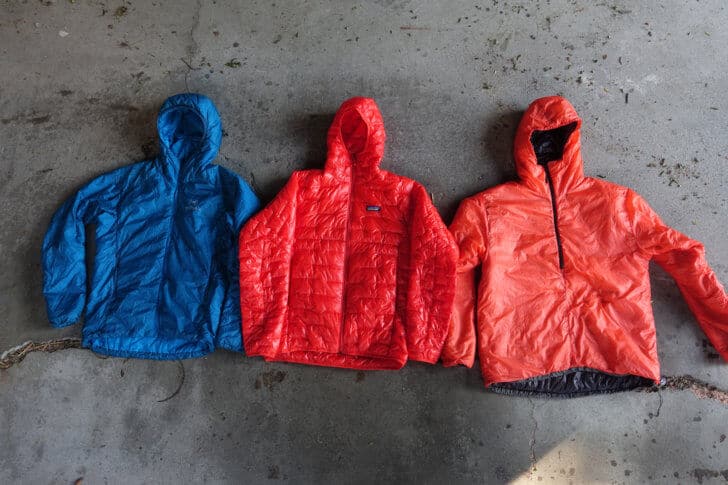
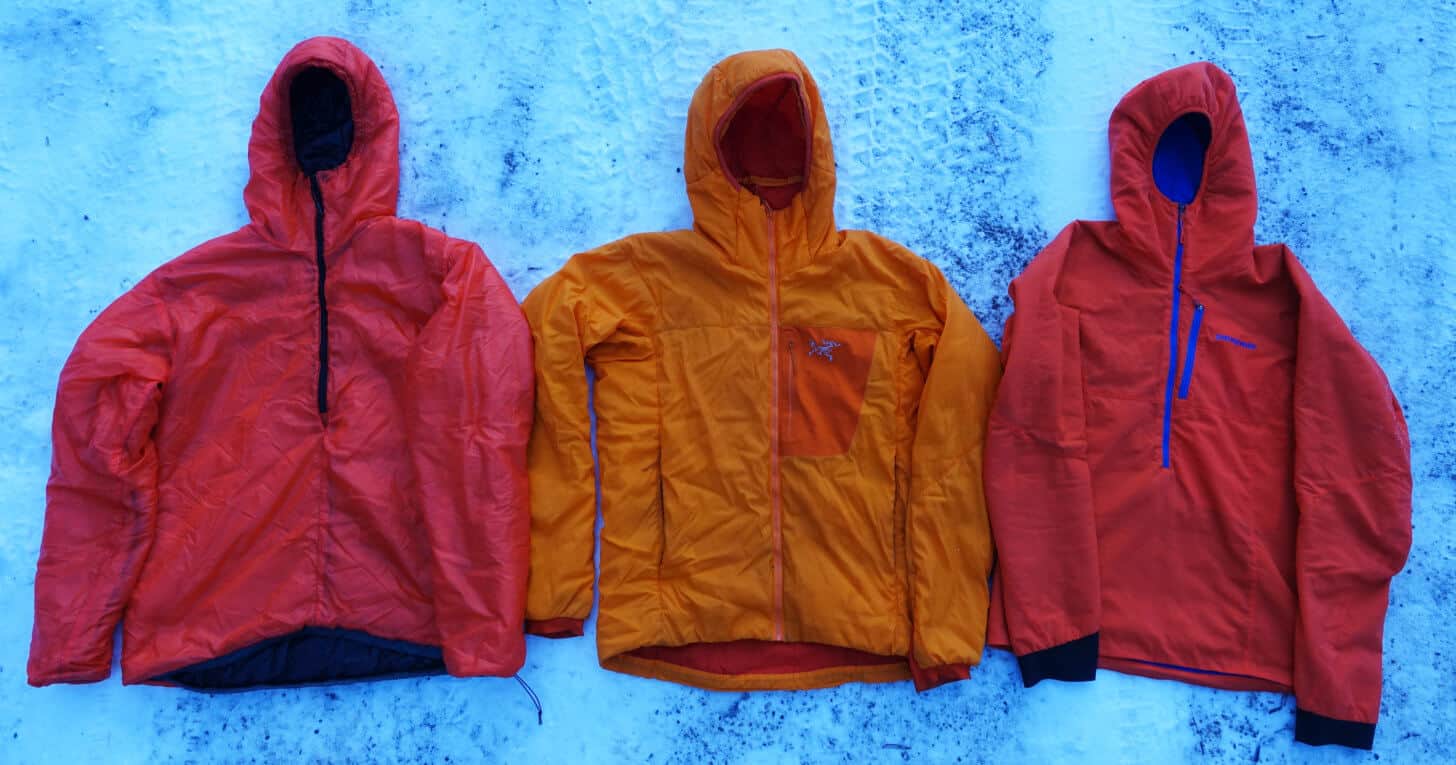
Introduction
The Patagonia DAS is our highest rated synthetic insulated parka. Frequent revisions have created a stunningly effective jacket for expeditions that cross multiple climates and for overnight alpine climbs and backcountry trips where a wet down parka would force you to bail, or worse. Despite a suite of expedition features, the premium insulation and light fabrics keep the DAS lightweight at only 22 oz. in men’s medium. This parka performs so well and is offered at such a reasonable price that we feel it’s the only highly-insulated synthetic parka worth buying.
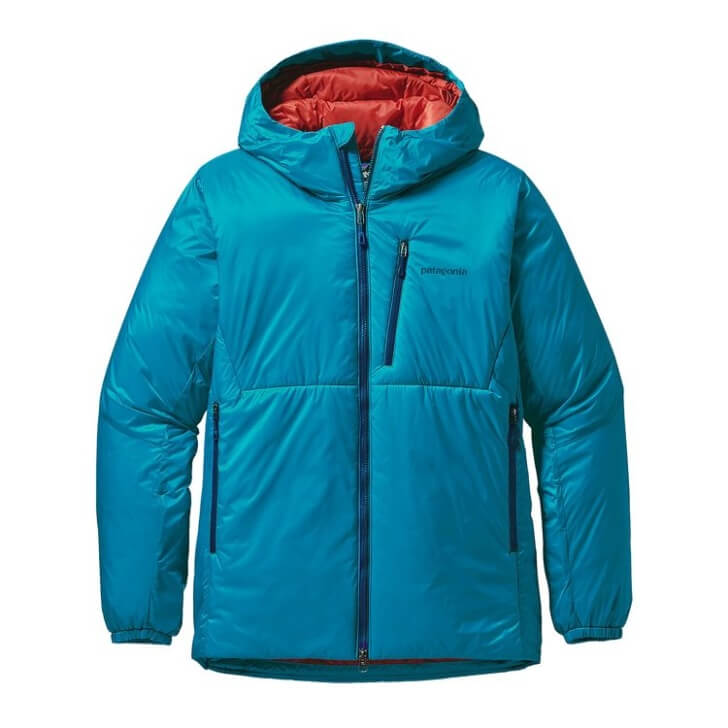
As we describe in detail below, synthetic insulated parkas (as opposed to less-insulated hooded jackets more suitable for layering or temperate weather) are only ideal for a small portion of winter activities. For the vast majority of multi-day trips, and almost all day trips, a down parka offers superior performance and is a better long-term value. However, if you do a lot of expeditions and/or committing alpine routes, we highly recommend the DAS.
The only synthetic parka we know of that’s better than the DAS is the $625 Arcteryx Dually Belay Parka, which is warmer and more durable (due to its 100% continuous filament insulation that’s laminated to the face fabric for added stability). Max used the Dually in 2014 and 2015. He also met with its designers and toured Arcteryx’s North Vancouver factory, where the parka is made. As much as we respect the Dually, we excluded it from this comparative evaluation because we feel its increased performance is not commensurate with the 2x+ price compared to the DAS!
Features
- Uses a combination of durable continuous filament insulation and high warmth to weight ratio short staple insulation
- Two interior drop-in pockets, two handwarmer pockets, and a chest pocket
- Huge, helmet compatible hood
- Excellent lightweight fabrics
Specifications and Performance Scores
Field Testing
Luc used the DAS for a 150-mile ski and skate trip and a month-long ski mountaineering trip. After we finished testing, he bought a DAS for his annual Alaska ski mountaineering expeditions that dip from wet valleys to frigid, high elevation peaks. Max has used several versions of the DAS in the past. He took this version on a two-week climb-ski-packraft trip and for a handful of climbing and skiing day trips.
Is it Worth Buying a Synthetic Insulated Parka?
You can’t go wrong with a synthetic parka, but using it as your primary parka will cost a lot more than owning both down and synthetic and using the synthetic only when needed.
The three most important factors to consider when choosing between a down and synthetic parka are: humidity, trip duration, and sleep setup. Down parkas are best for nearly all day trips because they’re more durable and can dry out at night. Increasing trip duration and humidity increases the probability of needing synthetic insulation. Similarly, sleeping in a confined, poorly ventilated bivy tent for five days or making an unplanned, exposed bivy might warrant synthetic insulation. Expeditions that cross multiple climates, i.e. travel through rainy valleys and up to frigid, high peaks are one of the few times when a synthetic parka is definitely the best choice.
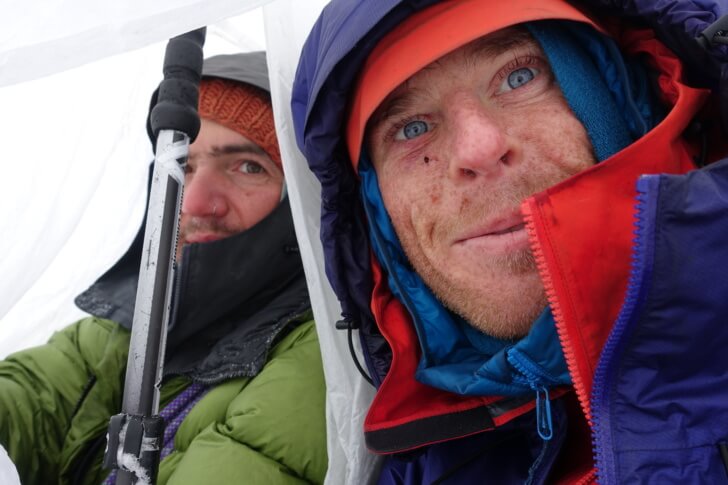
When is a Synthetic Parka Best for Climbing?
Patagonia built the DAS as a belay parka. However, both Max and his friend Chris (Chris previously led synthetic parka testing for another outdoor media publisher), both moderately experienced alpinists, almost never use a synthetic parka for technical climbing. Why not? Because down performs better for the vast majority of routes.
We see a lot of climbers and mountaineers wearing synthetic parkas when they’d be better served by the long-term value of a down insulation. For most climbers, we don’t think it’s worth buying a synthetic parka. The nature of climbing has changed significantly over the past couple of decades such that the probability of a parka becoming harmfully wet is vastly less. This is due to much lighter gear, heaps of pre-climb information, lightweight satellite communication devices, and better access. In most cases and places, people wait for a weather window and launch with a down parka.
We asked Colin Haley, a Patagonia Ambassador and cutting-edge alpinist, when he uses a synthetic parka. He said,
Whether I bring a down parka or a synthetic parka is dependent mostly on climate. Some places are simply much more humid than others. For example, March in the Cascades is much more humid than October in Nepal, so I’m more likely to carry a synthetic parka. Sometimes there can be a noticeable climatic difference across a very small distance. For example, in Patagonia, I always use synthetic parkas when climbing on the Torres (which are right against the South Patagonian Icecap) and down parkas when climbing in the Chaltén (Fitz Roy) Group, which is only a few kilometers further east, but much drier.
The DAS works fine in high alpine environments, where precipitation comes only as snow, but our tests show that the higher warmth to weight ratio and vastly better long-term durability of down parkas makes them a smarter choice there. In addition to the good selection of more weather resistant down parkas (Rab Neutrino Endurance, Feathered Friends Volant, Western Mountaineering Snojack, Crux Magma, etc.), we’re seeing a trend toward increasing down parka water resistance. Patagonia’s Grade VII Parka has welded baffles in key areas and Arcteryx’s Firebee AR parka uses a fully seam-taped Gore Thermium (more water resistant than Windstopper) fabric. We recommend a down parka with a durable, water-resistant fabric for all day trips and most multi-day trips in winter.

Performance Evaluation
Warmth
Patagonia aced the warmth to weight balance in the DAS. It uses 4.23 oz. (120g) PrimaLoft Silver Hi-Loft insulation and has an additional layer of 2.12 oz. (60g) PrimaLoft Gold in the torso. This is a smart combination that provides both durability (due to the continuous filament Hi-Loft) and good performance when wet (according to Primaloft, Gold’s wet clo value is 0.9 oz/yd while Hi-Loft’s is 0.6 oz.yd). The tiny fibers of Primaloft Gold also give the parka a soft, smooth hand.
With very warm mid layers underneath, the DAS is warm enough for a late June or July ascent of Denali. Down parkas, of course, work better on that mountain but the point is: this parka is pretty darn warm. Luc and Sarah compared the DAS and Patagonia’s Fitz Roy (down parka) on a week-long Nordic skating trip in Alaska’s Yukon Delta and found the DAS to be warmer. (The Fitz Roy doesn’t have enough down in the arms). Max and Eric compared the DAS and the Feathered Friends Hooded Helios on a 13-day climbing-ski mountaineering-packrafting trip in the Alaska Range and also found the DAS to be warmer. (Even after being extended an inch in 2014, the Hooded Helios is significantly shorter than the DAS; lacks a waist drawcord and has no interior drop-in pockets). Thus, we’re confident the DAS is warmer than most 18 oz. (510.29 g) down parkas. It is not as warm as down parkas that weigh a bit more than the DAS; we’ve found the Feathered Friends Volant (through extensive use) and Western Mountaineering Snojack (through trying it on once) to be warmer. We also expect the forthcoming Firebee AR and Grade VII to be warmer than the DAS.
The Montane Spitfire One, which weighs a whopping 31.4 oz. (890.18 g), is the warmest synthetic parka we tested in this review series.
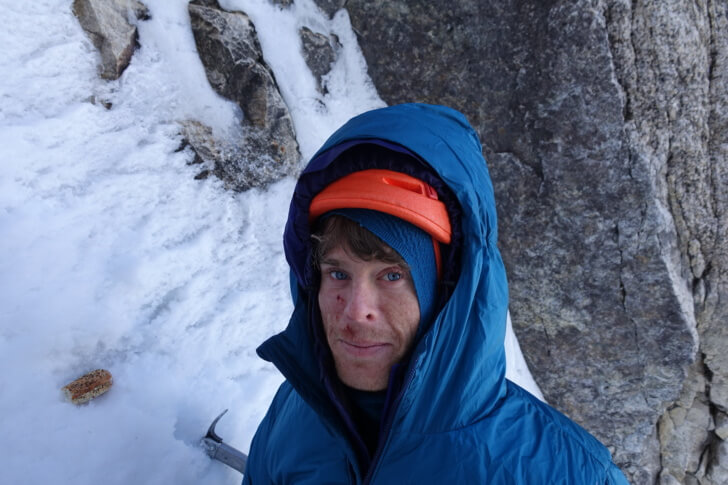
Weather Resistance
The DAS has a 1.2 oz. (34.02 g) 20-denier Pertex Endurance PU coated ripstop nylon shell. This is sufficient for resisting light moisture. Primarily because it keeps the parka in the appropriate weight class, we think it’s a great fabric choice.
The Arcteryx Nuclei AR and Kappa Hoody use seam-taped Gore Thermium fabrics that are significantly more water resistant, and also warmer because the fabric traps a lot of air. The Montbell Thermawrap Guide’s fabric is also more water resistant than the DAS. It would be amazing, and considerably more expensive if Patagonia built the DAS with a lightweight seam-taped Gore Thermium fabric.
Breathability
The DAS is not intended to be highly breathable.

Durability
Patagonia sacrifices some durability by using a 60g layer of Primaloft Gold insulation over the 120g layer of Silver Hi-Loft. This very fine microfiber insulation makes the jacket feel soft to the touch, increases its warmth when wet, and slightly increases the overall warmth to weight ratio. Unfortunately, it also significantly decreases durability. Over the long-term, the DAS would retain more loft if it were made exclusively from a continuous filament insulation.
Previous versions of the DAS had extra tough fabric on the arms and shoulders. We’re glad Patagonia did away with this. Our testing shows that most synthetic insulations degrade faster than their enclosing fabrics when used for multi-day, frequent compression activities. Thus, there’s no need for a tough fabric on the DAS. (We do, however, prefer tougher fabrics on high wear areas of down parkas because their insulation lasts much longer.) If you rip the DAS fabric, just cover it with some repair tape. No big deal.
Comfort
We give the DAS 10 out of 10 points here because Patagonia did a splendid job with all of its features. Unlike the Arcteryx Kappa, the chest pocket is well insulated. The handwarmer pockets are well-insulated. The interior drop-in pockets are huge and set high, so they don’t sag beyond the hem when loaded with goodies and are made of stretchy mesh that allows you to see what’s in them. The hood is big and provides a lot of coverage for the neck and chin. The length is long enough to cover your butt. The two-way zipper lets you unzip to better use a belay device. Fantastic work, Patagonia.
Note for people with excessively long arms: The DAS’ sleeves may not be long enough for you. Max (6’1” with a +2” ape index) found them about 2” too short. Consider sizing up or going with a different brand if your arms are longer than Max’s. (Max didn’t find the length to be problematic because glove and mitten gauntlets covered the small gap between the hand and the sleeve).
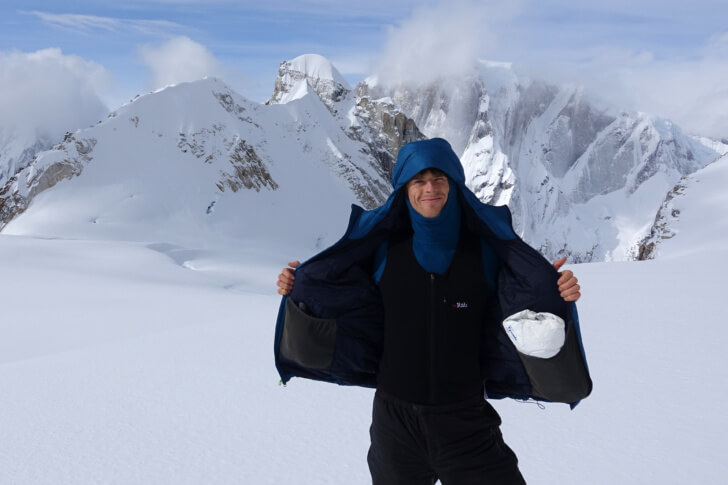
Weight
Our men’s medium weighs 22.0 oz. (623 g). This is surprisingly light for how warm the parka is. The included stuff sack, which we rarely use, weighs 0.2 oz. (5.6 g).
Summary: Patagonia DAS Parka Review
Strengths
- Highest warmth to weight ratio of all synthetic insulated parkas
- Excellent design, construction, and materials – our highest rated synthetic insulated parka
Limitations
- Parkas made exclusively with continuous filament insulations, e.g. Arcteryx Dually Belay and Black Diamond Stance Belay, are more durable. However, the DAS is half the cost of the Dually and significantly better than the Stance Belay; the DAS receives our highest recommendation.
Recommended Uses
- Expeditions that cross multiple climates
- Humid multi-day trips
- Longer duration (3+ day) alpine climbs
- Anything with a high probabilty of an unplanned bivy in bad weather
Compared To
At $300 retail, and available for 40% off at Patagonia’s bi-annual sales, the DAS is a very good value. It’s at least twice as warm as their $300 Nano Air Hoody.

Related Content
This review is part of a comprehensive State of the Market survey of synthetic insulated jackets that has been ongoing for the past two years. Included in this survey:
- Arc’teryx Kappa Hoody Review
- Patagonia Nano Air Hoody Review
- Outdoor Research Uberlayer Review
- Rab Xenon X Review
- Montbell Thermawrap Guide Review
- Rab Nimbus Review
- Patagonia Nano Air Light Review
- LLBean Primaloft Packaway Review
- Arc’teryx Proton LT Review
- Black Diamond Heat Treat Hoody Review
- Patagonia Micro Puff Hoody Review
- Arc’teryx Nuclei FL Jacket Review
- Nunatak Skaha Apex Review
- Montane Spitfire Parka Review
- Arc’teryx Nuclei AR Parka Review
- Patagonia DAS Parka Review (this article)
- Synthetic Insulated Jackets State of the Market Report (TBA March 25)
Disclosure
The manufacturer provided a sample of this product to the author with no agreement, requirement, or obligation for media coverage of any kind. Some links are affiliate links, which means if you click through and make a purchase, Backpacking Light gets a small commission on the sale. This comes at no extra cost to you and helps support Backpacking Light’s efforts to publish authoritative and valuable information about lightweight backpacking gear and techniques, inspiring stories and film festivals, and remain an active member of the outdoor industry to promote and protect opportunities for public outdoor recreation.

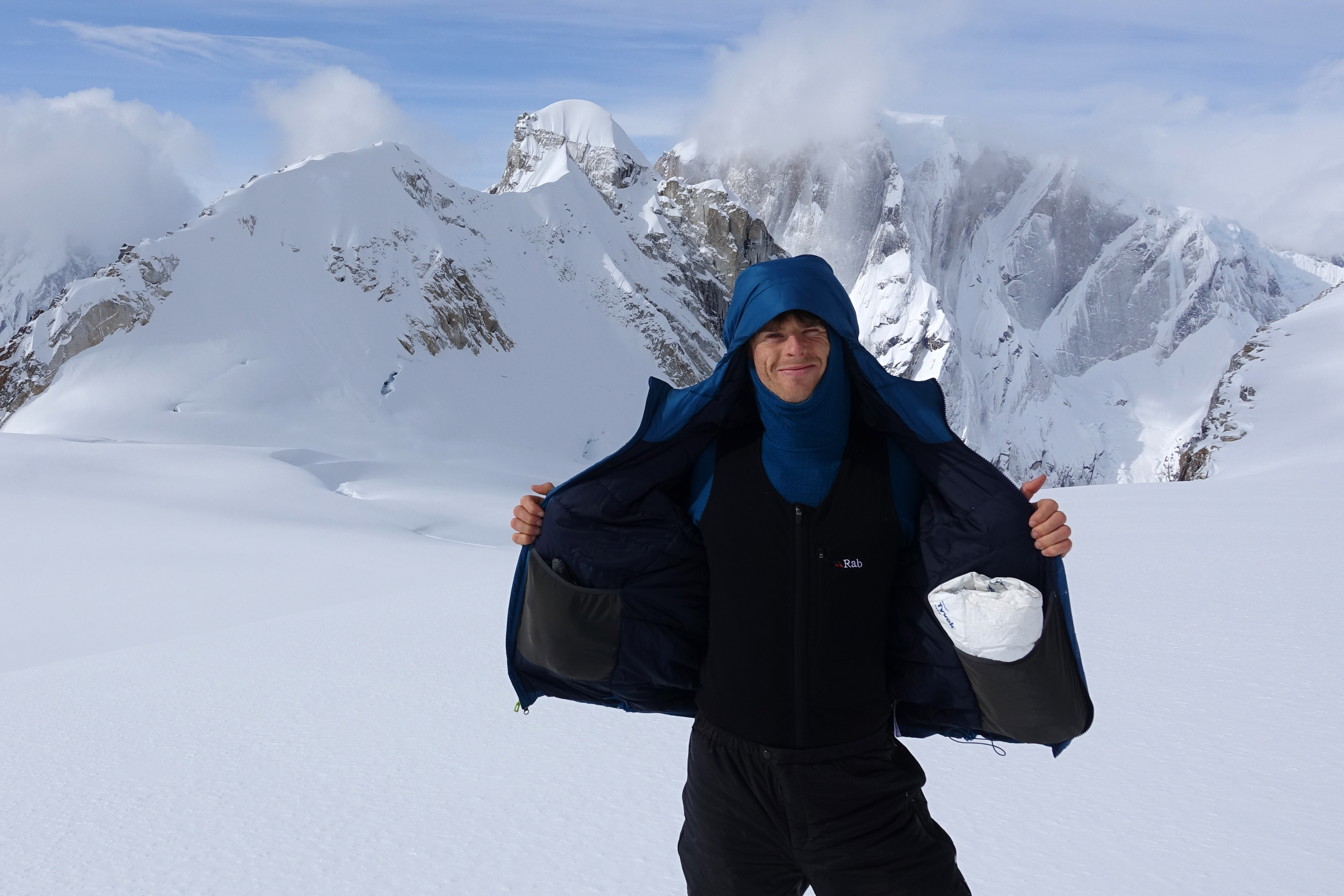


Home › Forums › Patagonia DAS Parka Review